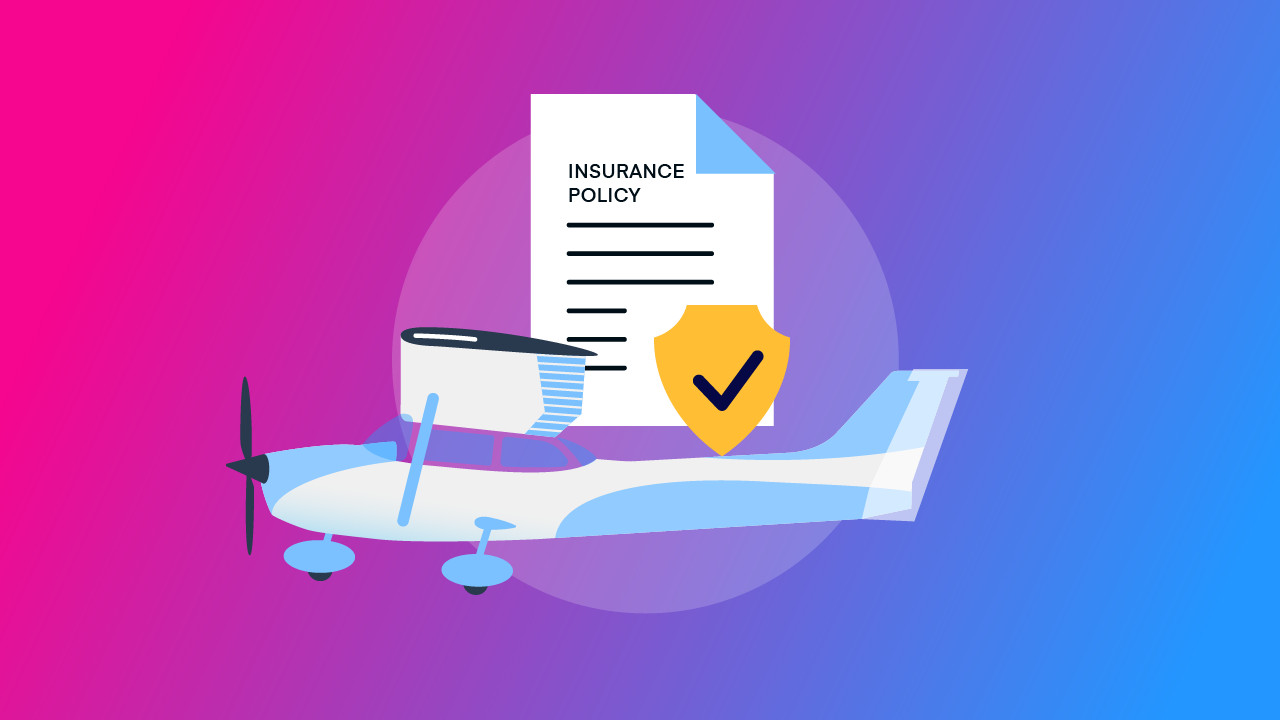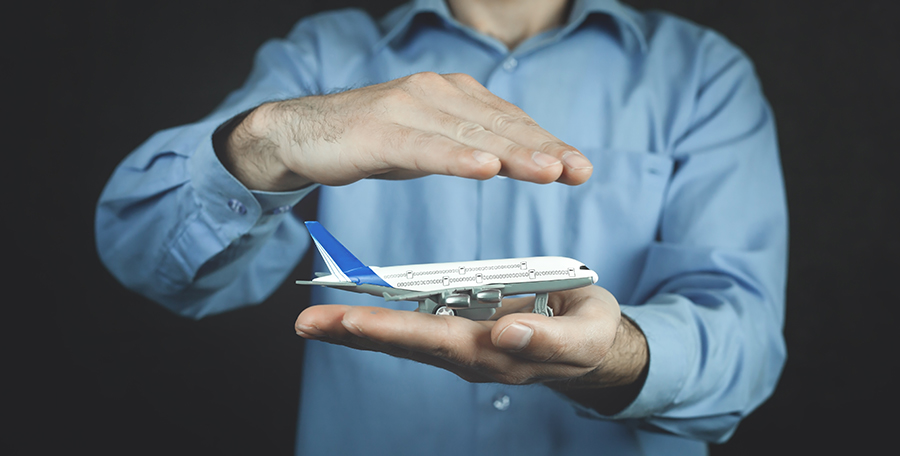We don’t need to tell you that accidents can be a real pain in the neck, and especially in the wallet. As a pilot, you’re trained to be prepared for emergencies and accidents–but are you also ready for the bill?
Whether you’re a first-time aircraft owner or have an entire fleet, you’ll want the protection of an aircraft owner’s insurance. We’re here to explain how it works so you’ll be flying with an easy mind and a secure bank account.
Key Takeaways
- Aircraft owner’s insurance provides financial protection for your aircraft, passengers, and damages caused by your plane.
- Different types of insurance policies include: hull, liability, combined single limit, and hangar.
- The cost of your insurance will depend on factors like aircraft value, pilot experience, and location.
- Logging more flight hours, maintaining a clean record, using a hangar, and joining aviation associations can lower the cost of insurance.
- While not always legally required, aircraft insurance is recommended for financial protection.
What Is Aircraft Owner’s Insurance?
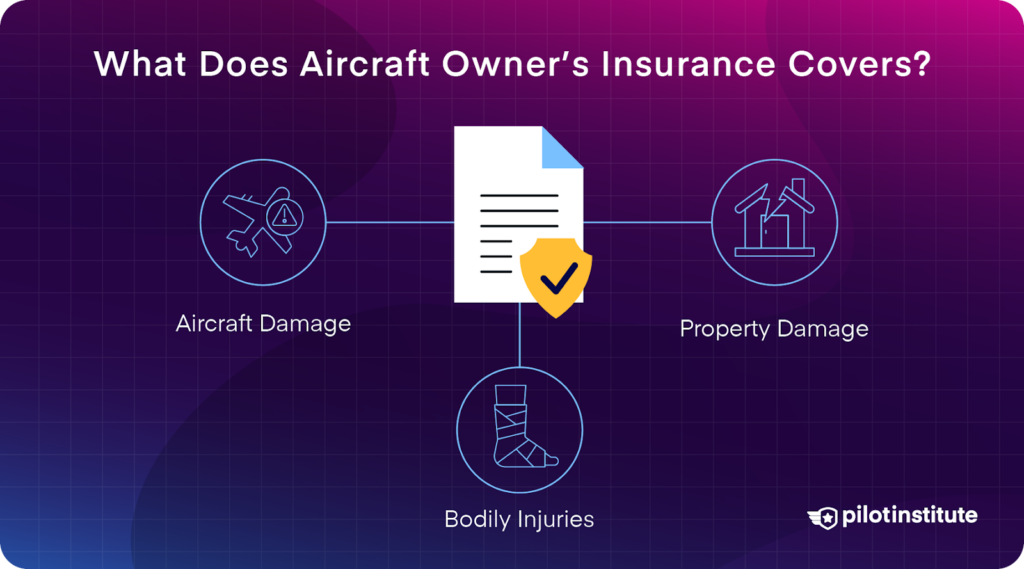
Aircraft owner’s insurance is a special type of insurance for people who own and fly aircraft. If your plane gets damaged, this insurance will help cover the costs. You can also get coverage if someone gets hurt or their property is damaged because of your aircraft.
Even if you make every effort to fly safely, emergencies can happen when you least expect them. Insurance gives you peace of mind, knowing you’re financially covered while flying.
You will be protected from the high costs of accidents or damage to your aircraft. Repairs, replacing your aircraft, or covering medical bills can set you back by thousands of dollars. Luckily, these can all be covered by insurance.
Types of Aircraft Insurance

There can be many types of aircraft owner’s insurance policies, each with its own coverage and limitations. There are distinctions in the fine print that each policy spells out.
Which ones will you need? Well, it depends on your needs and priorities.
To make things simple, we’ve narrowed it down to these general types. Let’s look at your choices one by one.
Hull Insurance
Physical damages to your aircraft are covered by hull insurance. These include damages caused by accidents, weather, vandalism, or other risks. Hull insurance will cover the expenses for repairing or replacing your aircraft.
However, not all hull insurance policies have the same coverage. All-risk coverage includes most types of damage, whether in-flight or on the ground. Of course, this policy can have certain exceptions, commonly natural wear and tear.
Ground-only coverage, or ground risk insurance, only covers physical damage that occurs while the aircraft is on the ground. On the other hand, in-flight coverage is for damages that happen to your aircraft in flight.
To learn more about your options, check out What Should Your Drone Insurance Cover?
Liability Insurance
Liability insurance is another important policy to have. If your aircraft causes injury to someone else or damages their property, this policy will have you covered.
Liability insurance is still a relatively broad term. It can come in different forms, so let’s look at some of your options.
Bodily injury liability covers settlements and medical expenses for people who were injured by your aircraft. Depending on your agreement, this could also cover the passengers inside your aircraft.
On the other hand, property damage liability covers damage to things like buildings or other aircraft.
However, we all know that injuries and damages typically go together in an accident. If you want financial protection from both, you should get a Combined Single Limit (CSL) in your policy. Combined single limits combine all components of a claim to a single dollar amount.
CSL doesn’t typically cover any injuries to the pilot of your aircraft. For this, you’ll need pilot medical coverage or occupant accident insurance. This policy provides medical coverage for the pilot and passengers injured in an accident.
Hangar Insurance
If you keep your aircraft in a hangar, hangar insurance can protect you from costs related to damage to the hangar itself.
For instance, if a storm damages the hangar where your aircraft is stored, this insurance would help pay for repairs.
Pilot Liability Insurance
If you own a commercial operation where other pilots fly your aircraft, you’ll want to get pilot liability insurance. Your pilots should have this extra layer of protection in case of unexpected accidents.
Here, the pilot responsible for an accident will be protected, regardless of aircraft ownership.
Choosing the Right Policy
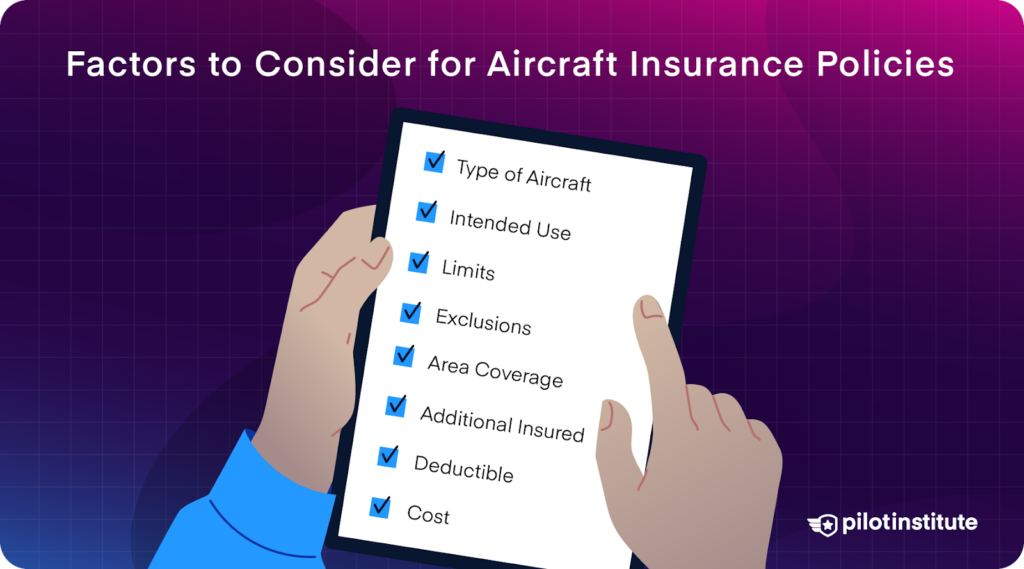
These are just some of the many insurance policies you can find, and searching for the right one can get confusing.
So, how can you choose the best policy for you?
First, check to see if your type of aircraft is eligible for insurance coverage. Here are a few examples of commonly insured aircraft:
- Single and Multi-Engine Aircraft
- Helicopters
- Jet (Turbine) Aircraft
- Seaplanes
- Drones
- Homebuilt Aircraft
- Experimental Aircraft
You should also consider the age and model of your aircraft. Insurance companies will see newer aircraft as less of a risk than older ones. That said, you’ll have an easier time insuring a 2024 Cessna than a 1974.
How you use your aircraft, or the intended use, also matters. Do you fly for personal or business use?
If you’re flying just for fun or for personal trips, you’ll only need basic coverage, such as hull and liability insurance.
However, if you use the aircraft for commercial purposes, you’ll need more extensive coverage because the risks are higher.
Insurance policies have limits, so you should ensure that your estimated costs are covered in the fine print. For example, a liability insurance policy might have $1 million in total coverage but only a $100,000 per person limit. Decide if you’re happy with the limits spelled out in the policy.
Additionally, every insurance policy has exclusions—situations or damages that are not covered. War, terrorism, natural wear and tear, and illegal activities are the most common exclusions. Be sure to understand these to avoid surprises later on.
Also, which areas do your aircraft usually fly in? Some policies limit international flights or specific regions, so ensure your usual routes are also covered.
If other people will be flying the aircraft, you’ll need to add them as “additional insured.” Commercial operations where other pilots fly the aircraft should have these pilots covered in their insurance policy.
You might also be charged with a deductible, so this is another factor to consider. A deductible is the amount you’ll pay out-of-pocket before insurance kicks in.
Higher deductibles usually mean lower premiums. However, you could also be paying more out-of-pocket in the event of a claim. Choose a policy that fits with your budget.
Lastly, you should consider the cost of the policies you’re choosing from.
The cost of aircraft insurance can vary widely depending on several factors. Make sure you choose a policy that fits your budget.
The Cost of Aircraft Owner’s Insurance
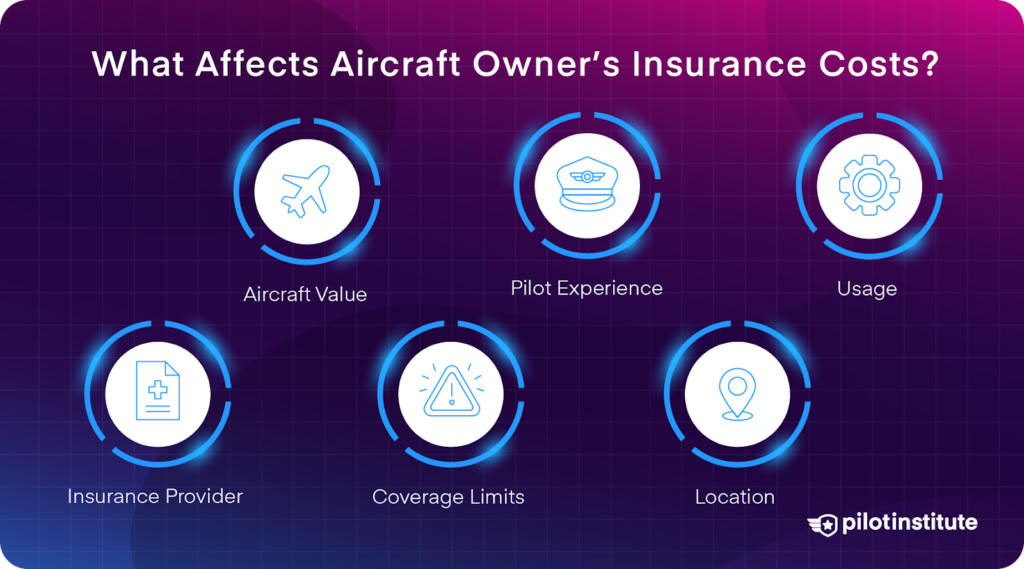
So, how do insurers determine the cost? Which factors can affect how much you’ll need to pay?
Have a drone? Check out our article What Factors Affect the Cost of Drone Insurance?.
Aircraft Value
First, the value of your aircraft directly affects your insurance cost. A more expensive aircraft will cost more to repair or replace.
For example, if you own a jet, you might pay more for hull insurance. To cover the potential risk, insurance companies will be charging more in premiums.
The age of your aircraft also plays a factor in its value. For a Cessna 172, around 1-5 years old, you could pay $800 to $1,500 annually in hull insurance. For an older Cessna, you could only pay $500 to $1,000.
Pilot Experience
Your flight experience also plays a big role in determining insurance costs. You’ll likely pay less if you have many flying hours and advanced certifications. You might even be offered discounts if you complete additional safety training or maintain a clean record. This also applies to drone owners.
A pilot with over 500 flying hours can be quoted a $600 to $1,000 premium for Cessna 172 hull insurance.
On the other hand, newer pilots may face higher premiums. Insurers see them as more prone to mistakes. You can expect to pay $1,200 to $1,800 annually if you’re a newer pilot.
Usage
How you use your aircraft also has an impact on the insurance cost. Do you fly just for fun? If so, your premiums will likely be lower than those for commercial purposes. You’ll likely pay only around $600 to $1,200 in premiums for a Cessna 172.
On the other hand, charter services or instruction flights are more exposed to risks. You’d be more likely to run into accidents, bad weather, or mechanical issues. This increase in risk exposure leads to higher premiums. Typically, these operations pay $1,500 to $2,500 per year.
Location
There’s also the question of where you store and fly your aircraft. Some areas are more prone to extreme weather conditions, like hurricanes or hailstorms.
If your aircraft is kept or flies in these areas, you can expect higher premiums because of the increased risk.
You might also pay more if you fly in regions with heavy air traffic or difficult terrain. You’re more likely to be involved in accidents in these areas.
Where do you store your aircraft? Keeping your aircraft in the open leaves your aircraft vulnerable to damage which can lead to higher premiums. On the flip side, storing your aircraft in a hangar comes with its own costs, but it will also protect aircraft on the ground. Weigh your budget and priorities, then decide which works for you.
For low-risk areas, expect a quote of around $500 to $1,000 per year for a Cessna 172. For high-risk areas, your premiums might increase to $1,200 to $2,000 per year.
Coverage Limits
The type of coverage and the limits you choose will significantly affect the cost of your policy. Comprehensive coverage, which includes in-flight, ground, and liability insurance, will come with higher premiums than basic coverage.
Additionally, higher limits mean your insurer would pay out more in case of a claim, so expect higher premiums.
For example, a comprehensive policy covering full replacement and additional protection can reach up to $1,200 to $2,000 in premiums.
It’s essential to balance the cost with the level of protection you need. Basic coverage can be suitable enough if you only fly recreationally. For a typical Cessna 172, basic coverage could cost just $600 to $1,200 per year.
Insurance Provider
Keep in mind that these amounts are just rough estimates based on what other aircraft owners have claimed. Your costs can vary with several other factors, including the insurance provider.
The numbers will ultimately depend on who’s giving the quote and the deal you make with your insurer. If you can create an open dialogue with a reputable insurance broker, you’ll reach a fair agreement that works for both parties.
Looking for recommendations? You can start your insurance search by reaching out to these companies:
AssuredPartners is the exclusive insurance provider for the Aircraft Owners and Pilots Association (AOPA). They offer a range of insurance products tailored specifically for AOPA members.
Ways to Reduce Aircraft Insurance Costs
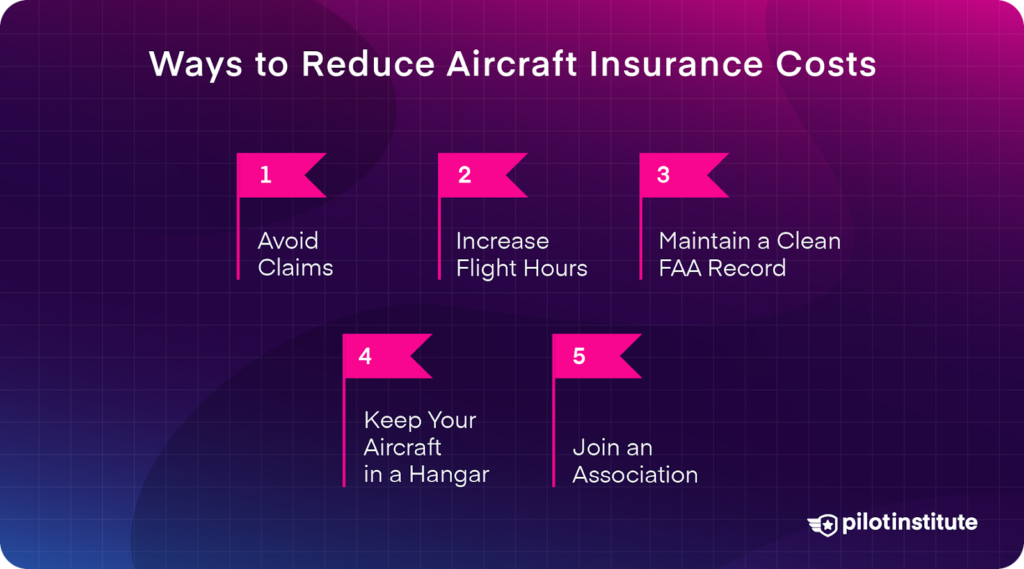
The good news, though, is that there are plenty of ways within your control to lower your premiums! If you’re a smart aircraft owner, you can save more per year with just a few extra measures.
So, how can you minimize your insurance costs?
Avoid Claims
Well, the best way is still to avoid claims.
Although this may seem to defeat the purpose, even small claims can significantly impact your future premiums. The increase in your yearly payments may be even larger than the payout you received from your claim.
For minor damages, consider paying out-of-pocket if you can. You’ll be saving more later on.
Increase Flight Hours
As mentioned previously, the number of flight hours you have also affects your risk factor to insurance companies. The number of flight hours you have directly influences your risk factor to the insurance companies. If you have over 5,000 hours, your risk of being involved in an accident reduces by 50%.
This will also depend on your hours per type and the aircraft you want to insure. As a result, you can expect a lower premium with an aircraft in which you have more flight hours.
Maintain a Clean FAA Record
Insurance companies will also look at two of your FAA records. They are:
- Your medical records
- Your flying record
If you’ve ever had your medical certificate revoked or reviewed, this can raise some flags for insurance companies. A spotty medical history can be seen as a risk, which could lead to higher premium options. This is why investing in your health is still the best financial decision.
Aside from staying in shape, you should maintain a clean flight record. Insurers will see any previous accidents, incidents, and license suspensions. A spotless flying record will demonstrate you as a responsible, low-risk pilot.
Keep Your Aircraft in a Hangar
Where do you keep your aircraft? Another smart tip to reduce insurance costs is to keep your aircraft in a hangar. Having one can help lower your premiums because it reduces the risk of damage.
When your aircraft is kept in a secure, enclosed space, it’s less likely to suffer from vandalism, hail, or wind damage. Insurers see hangar storage as a protective measure that lowers the chance of filing a claim, so they reward owners with lower premiums.
Join an Association
Lastly, consider joining an association. Many associations have partnerships with insurance companies. Members enjoy plenty of perks, such as discounted insurance rates.
These organizations often promote safety, provide training opportunities, and create a community of responsible pilots.
By joining an association, you show insurers that you’re committed to safe flying practices and continuous learning.
Additionally, some associations may offer group insurance plans. The combined lower risk of members results in more affordable premiums for everyone involved!
Flying Without Aircraft Insurance?
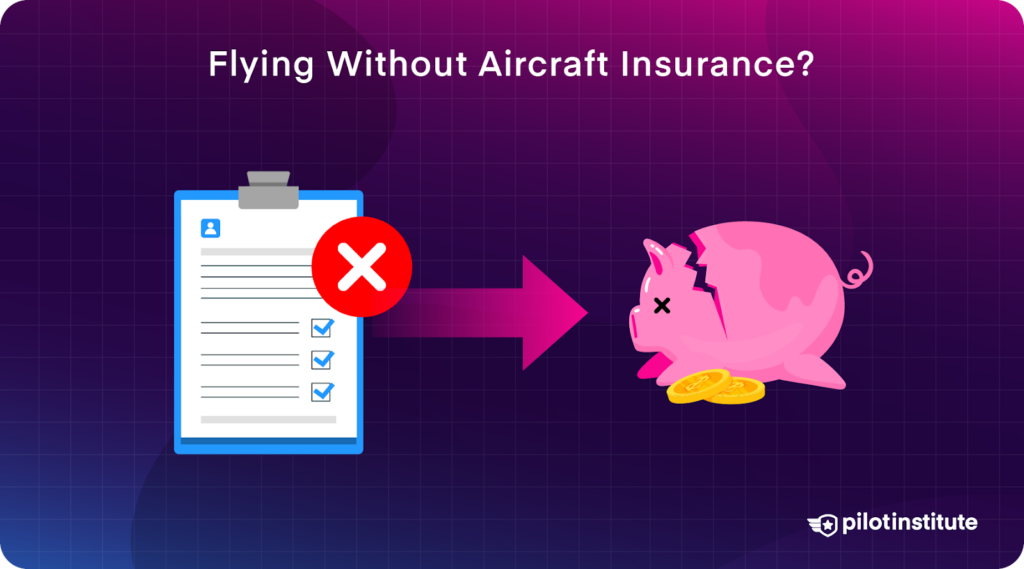
Have you ever heard of the phrase “flying naked?” It simply means flying uninsured. You’ll be surprised that there are pilots who do this, and there’s more of them than you think.
But is this even allowed?
Unlike auto insurance, there’s no minimum requirement for aircraft insurance. On a federal level, it’s completely legal for aircraft owners to not own any kind of policy.
You can be covered for property damage and bodily injury but have no hull insurance. This is enough coverage for some pilots. However, there are also those who fly with no coverage at all.
Only 11 states require liability insurance. And in California, you’ll be required to demonstrate financial responsibility, which entails having an insurance policy. Some airports also require insurance for you to use their facilities.
This means that the choice of whether or not to get insurance is entirely yours.
So, is getting insurance the right choice for you? To help you properly analyze the risk, let’s look at this sample accident scenario.
Let’s say that while you were taxiing, you accidentally collided your 2014 Cessna 172 with a 2010 Van’s RV-6A. Both aircraft sustained moderate damage.
You have a combined single-limit policy of $1,000,000 and an all-risk hull coverage of $90,000. You paid a deductible of $2,500 for your hull insurance, and you pay a total of $950 in total premiums annually.
After the damage was evaluated, it will cost $30,000 to repair the Van’s RV-6A, and $25,000 to repair your Cessna 172.
Without insurance, you would have paid $55,000 out of pocket for repairing both aircraft.
With insurance, you would only have paid the $2,500 deductible and $9,500 in premiums over 10 years. This amount would total $12,000.
However, the insurance payout would cover all repair costs for both aircraft. This would have saved you $43,000!
Conclusion
At the end of the day, deciding to get aircraft owner’s insurance depends on your needs and risk tolerance. Balancing coverage options with your flying habits will help you choose the best policy.
While it’s not always legally required, it’s a wise investment for most aircraft owners. However, if you’re a responsible owner, you may never need one at all!
